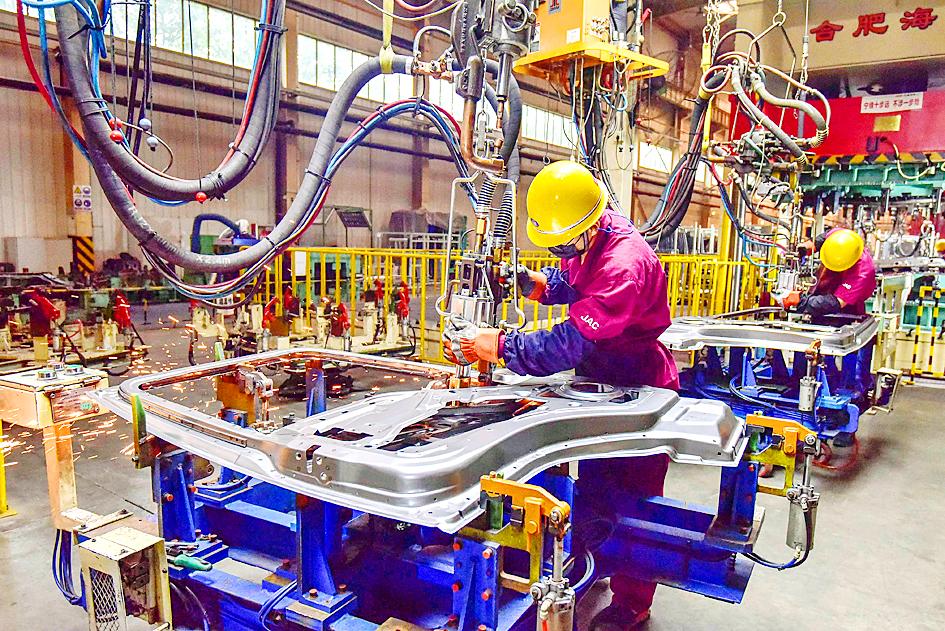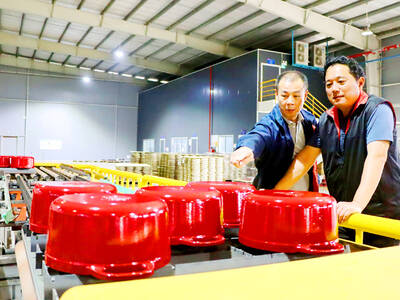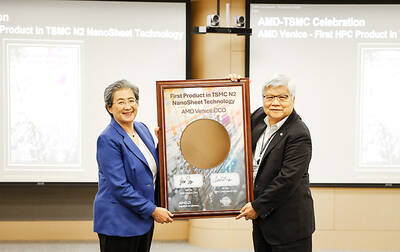Activity in China’s vast factory sector contracted last month for the first time since the COVID-19 pandemic began, the latest sign of deceleration in the world’s second-largest economy.
The drop in the official manufacturing purchasing managers’ index below 50, which signals a decline in output, shows the damage a widespread electricity crunch is having on growth.
Alongside tough measures to rein in the property market, the latest developments have led economists to pare back full-year growth predictions below 8 percent and warn that Beijing could be willing to tolerate a sharper slowdown as it tries to reform its economic model.

Photo: AFP
The problem for the economy is that manufacturing and property investment have been the main drivers of growth since the pandemic hit, while consumption growth remains relatively weak with households still cautious about travel and eating out.
Property curbs and electricity shortages, which have caused power cuts across China this week, were “a double whammy on the key drivers of growth this year,” said Bo Zhuang, China economist at Loomis Sayles Investments Asia. “A further growth slowdown is inevitable.”
Beijing is focused on preventing instability. The central bank told financial institutions that to prevent fallout from the property slowdown, which has exacerbated a debt crisis at China Evergrande Group (恆大集團), targeted financial easing aimed at the manufacturing sector might be likely.
However, economists see little prospect of relaxation on tough policy, such as curbs on housing purchases and energy use limits, until December, when Chinese President Xi Jinping (習近平) and top officials meet to set economic priorities.
“Additional policy support will need to come soon to avert a sharp deceleration in growth. The economy’s near-term outlook is highly challenging and uncertain. Headwinds include softening external demand, continued virus risks and a lack of fast, ready solutions for the energy shortages. Regulatory tightening is also a significant drag,” Bloomberg Economics said.
When the government set its growth target at “above 6 percent” in March, economists saw it as modest against their own predictions of greater than 8 percent. Many are now rethinking their views, with major banks from Goldman Sachs Group Inc to Nomura Holdings Ltd downgrading their forecasts in recent weeks to as low as 7.7 percent.
Chinese factories in 21 provinces have been hit by power cuts in the past few weeks, largely driven by a spike in coal prices that made it unprofitable for power plants to sell electricity at fixed prices. The brunt of the effect was in the official manufacturing purchasing managers’ index, which declined to 49.6 from 50.1 in August, below the 50 median estimate in a Bloomberg survey of economists.
Beijing has scrambled to solve the problem by allowing power companies to raise prices and funneling more coal to the sector. Those efforts could get production going again in many factories, but that relief might not come for weeks.
Beyond that, Beijing is signaling that it wants highly energy-intensive producers, like steel and chemical factories, to reduce output for the rest of the year, as it tries to meet environmental targets. China’s aim to reduce energy intensity, or how much power is needed to drive output, by about 3 percent this year could drag down full-year growth by 0.3 to 0.6 percentage points, said Ming Ming (明明), head of fixed income research at Citic Securities Co.
A rollback of energy intensity targets before the end of the year is unlikely, said Chen Long (陳龍), a partner at consulting firm Plenum.

TAKING STOCK: A Taiwanese cookware firm in Vietnam urged customers to assess inventory or place orders early so shipments can reach the US while tariffs are paused Taiwanese businesses in Vietnam are exploring alternatives after the White House imposed a 46 percent import duty on Vietnamese goods, following US President Donald Trump’s announcement of “reciprocal” tariffs on the US’ trading partners. Lo Shih-liang (羅世良), chairman of Brico Industry Co (裕茂工業), a Taiwanese company that manufactures cast iron cookware and stove components in Vietnam, said that more than 40 percent of his business was tied to the US market, describing the constant US policy shifts as an emotional roller coaster. “I work during the day and stay up all night watching the news. I’ve been following US news until 3am

UNCERTAINTY: Innolux activated a stringent supply chain management mechanism, as it did during the COVID-19 pandemic, to ensure optimal inventory levels for customers Flat-panel display makers AUO Corp (友達) and Innolux Corp (群創) yesterday said that about 12 to 20 percent of their display business is at risk of potential US tariffs and that they would relocate production or shipment destinations to mitigate the levies’ effects. US tariffs would have a direct impact of US$200 million on AUO’s revenue, company chairman Paul Peng (彭雙浪) told reporters on the sidelines of the Touch Taiwan trade show in Taipei yesterday. That would make up about 12 percent of the company’s overall revenue. To cope with the tariff uncertainty, AUO plans to allocate its production to manufacturing facilities in

Six years ago, LVMH’s billionaire CEO Bernard Arnault and US President Donald Trump cut the blue ribbon on a factory in rural Texas that would make designer handbags for Louis Vuitton, one of the world’s best-known luxury brands. However, since the high-profile opening, the factory has faced a host of problems limiting production, 11 former Louis Vuitton employees said. The site has consistently ranked among the worst-performing for Louis Vuitton globally, “significantly” underperforming other facilities, said three former Louis Vuitton workers and a senior industry source, who cited internal rankings shared with staff. The plant’s problems — which have not

COLLABORATION: Given Taiwan’s key position in global supply chains, the US firm is discussing strategies with local partners and clients to deal with global uncertainties Advanced Micro Devices Inc (AMD) yesterday said it is meeting with local ecosystem partners, including Taiwan Semiconductor Manufacturing Co (TSMC, 台積電), to discuss strategies, including long-term manufacturing, to navigate uncertainties such as US tariffs, as Taiwan occupies an important position in global supply chains. AMD chief executive officer Lisa Su (蘇姿丰) told reporters that Taiwan is an important part of the chip designer’s ecosystem and she is discussing with partners and customers in Taiwan to forge strong collaborations on different areas during this critical period. AMD has just become the first artificial-intelligence (AI) server chip customer of TSMC to utilize its advanced